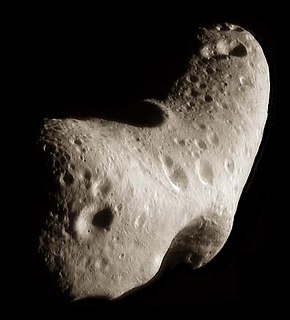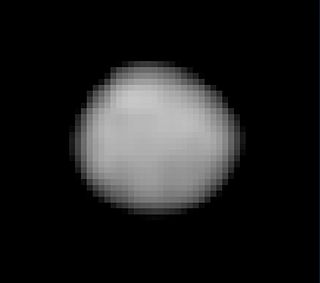This article needs additional citations for verification .(June 2016) (Learn how and when to remove this template message) |
Q-type asteroids are relatively uncommon inner-belt asteroids with a strong, broad 1 micrometre olivine and pyroxene feature, and a spectral slope that indicates the presence of metal. There are absorption features shortwards and longwards of 0.7 µm, and the spectrum is generally intermediate between the V and S-type.

The asteroid belt is the circumstellar disc in the Solar System located roughly between the orbits of the planets Mars and Jupiter. It is occupied by numerous irregularly shaped bodies called asteroids or minor planets. The asteroid belt is also termed the main asteroid belt or main belt to distinguish it from other asteroid populations in the Solar System such as near-Earth asteroids and trojan asteroids. About half the mass of the belt is contained in the four largest asteroids: Ceres, Vesta, Pallas, and Hygiea. The total mass of the asteroid belt is approximately 4% that of the Moon, or 22% that of Pluto, and roughly twice that of Pluto's moon Charon.

The micrometre or micrometer, also commonly known by the previous name micron, is an SI derived unit of length equalling 1×10−6 metre ; that is, one millionth of a metre.

The mineral olivine is a magnesium iron silicate with the formula (Mg2+, Fe2+)2SiO4. Thus it is a type of nesosilicate or orthosilicate. It is a common mineral in Earth's subsurface but weathers quickly on the surface.
Q-type asteroids are spectrally more similar to ordinary chondrite meteorites (types H, L, LL) than any other asteroid type. This has led scientists to speculate that they are abundant, but only about 20 of this type has been characterized. [1] Examples of Q-type asteroids are: 1862 Apollo, 2102 Tantalus, 3753 Cruithne, 6489 Golevka, and 9969 Braille.

The ordinary chondrites are a class of stony chondritic meteorites. They are by far the most numerous group and comprise about 87% of all finds. Hence, they have been dubbed "ordinary". The ordinary chondrites are thought to have originated from three parent asteroids, with the fragments making up the H chondrite, L chondrite and LL chondrite groups respectively.

The H type ordinary chondrites are the most common type of meteorite, accounting for approximately 40% of all those catalogued, 46% of the ordinary chondrites, and 44% of the chondrites. The ordinary chondrites are thought to have originated from three parent asteroids, whose fragments make up the H chondrite, L chondrite and LL chondrite groups respectively.

The L type ordinary chondrites are the second most common group of meteorites, accounting for approximately 35% of all those catalogued, and 40% of the ordinary chondrites. The ordinary chondrites are thought to have originated from three parent asteroids, with the fragments making up the H chondrite, L chondrite and LL chondrite groups respectively.






